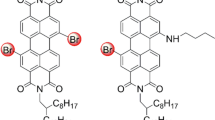Abstract
The electron spin echo (ESE) technique is applied to determine the spin relaxation times of long-lived light-induced radicals and short-term spin-correlated radical pairs (SCRPs) formed by the laser flash of a composite consisting of [6,6]-phenyl-C61-butyric acid methyl ether (PCBM) and poly-(3-hexylthiophene) (P3HT) at 80 K. The ESE signal dependences recorded to measure the longitudinal relaxation times of P3HT+/PCBM− SCRPs and the free P3HT+ radical are fitted by the exp(-(t/T 1)0.6) dependence with T 1 values lying in the microsecond time scale. The difference in the transverse spin relaxation times of the P3HT+/PCBM− radical paira appeared after selective and non-selective echo-detected EPR spectrum excitation is explained by the instantaneous diffusion model. Based on the model, the magnetic interaction energy between the electron spins in P3HT+/PCBM− SCRPs is estimated; E/ħ ∼ 106 s−1.
Similar content being viewed by others
References
M. A. Green, K. Emery, Y. Hishikawa, et al., Prog. Photovolt: Res. Appl., 21, No. 1, 1 (2013).
J. L. Bredas, J. E. Norton, J. Cornil, et al., Acc. Chem. Res., 42, No. 11, 1691 (2009).
P. A. Troshin, R. N. Lyubovskaya, and V. F. Razumov, Nanotechnologies in Russia, 3, Nos. 5/6, 56 (2008).
M. T. Dang, L. Hirsch, and G. Wantz, Adv. Mater., 23, No. 31, 3597 (2011).
S. Cook, R. Katoh, and A. Furube, J. Phys. Chem. C, 113, No. 6, 2547 (2009).
V. D. Mihailetchi, H. X. Xie, B. de Boer, et al., Adv. Funct. Mater., 16, No. 5, 699 (2006).
W. J. Grzegorczyk, T. J. Savenije, T. E. Dykstra, et al., J. Phys. Chem. C, 114, No. 11, 5182 (2010).
S. C. J. Meskers, P. A. Hal, and J. H. Spiering, Phys. Rev. B, 61, No. 15, 9917 (2000).
S. Singh and Z. V. Vardeny, Materials, 6, No. 3, 897 (2013).
J. Piris, T. E. Dykstra, A. A. Bakulin, et al., J. Phys. Chem. C, 113, No. 17, 14500 (2009).
J. M. Guo, H. Ohkita, H. Benten, et al., J. Am. Chem. Soc., 133, No. 17, 6154 (2010).
J. Behrends, A. Sperlich, A. Schnegg, et al., Phys. Rev. B, 85, No. 12, 125026 (2012).
H. Tanaka, Y. Yokoi, and N. Hasegawa, J. Appl. Phys., 107, No. 8, 083708 (2010).
C. Carati, L. Boholdi, and R. Po, Phys. Rev. B, 84, No. 24, 245205 (2011).
Y. Kobori, R. Noji, and S. Tsuganewa, J. Phys. Chem. C, 117, No. 4, 1589 (2013).
M. N. Uvarov and L. V. Kulik, Appl. Magn. Res., 44, No. 1, 97 (2013).
O. G. Poluektov, S. Filippone, N. Martin, et al., J. Phys. Chem. B, 114, No. 45, 14426 (2010).
A. Sperlich, H. Kraus, C. Deibel, et al., J. Phys. Chem. B, 115, No. 46, 13513 (2011).
V. I. Krinichnyi, E. I. Yudanova, and N. G. Spitsina, J. Phys. Chem. C, 114, No. 39, 16756 (2010).
A. J. Hoff, P. Gast, S. A. Dzuba, et al., Spectrochim. Acta A, 54, No. 14, 2283 (1998).
O. Schiemann and T. F. Prisner, Quart. Rev. Biophys., 40, No. 1, 1 (2007).
K. M. Salikhov, A. G. Semenov, and Yu. D Tsvetkov, Electron Spin Echo and its Application [in Russian], Nauka, Novosibirsk (1976).
M. Emshwiller, E. L. Hahn, and D. Kaplan, Phys. Rev., 118, No. 2, 414 (1960).
V. F. Yudanov, K. M. Salikhov, G. M. Zhidomirov, and Yu. D Tsvetkov, Theoretical and Experimental Chemistry, 5, No. 5, 451 (1969).
O. G. Poluektov, S. V. Paschenko, and L. M. Utshig, Phys. Chem. Chem. Phys., 11, No. 31, 6750 (2009).
Author information
Authors and Affiliations
Corresponding author
Additional information
Original Russian Text © 2014 M. N. Uvarov, A. G. Popov, E. A. Lukina, L. V. Kulik.
__________
Translated from Zhurnal Strukturnoi Khimii, Vol. 55, No. 4, pp. 679–685, July–August, 2014.
Rights and permissions
About this article
Cite this article
Uvarov, M.N., Popov, A.G., Lukina, E.A. et al. Spin relaxation and structure of light-induced spin-correlated PCBM−/P3HT+ radical pairs. J Struct Chem 55, 644–650 (2014). https://doi.org/10.1134/S0022476614040088
Received:
Published:
Issue Date:
DOI: https://doi.org/10.1134/S0022476614040088




